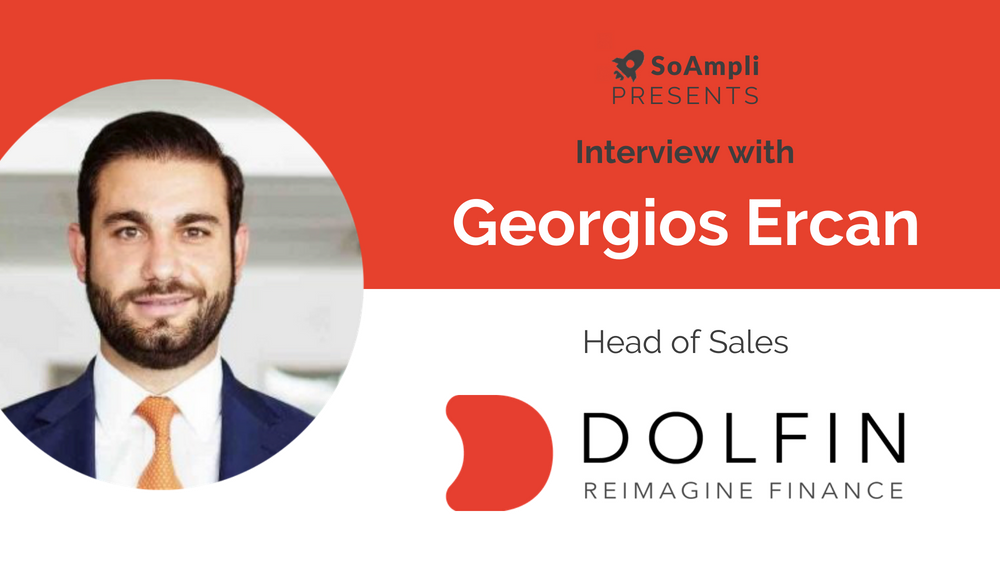In January 2017 Dolfin selected our award-winning lead generation platform for the company’s latest innovative marketing initiative.
Since then they have achieved some incredible results:
- 15% of traffic to the Dolfin website now comes from SoAmpli
- 2,947 posts shared to social media
- 3,165,090 people reached on social media
- 26,788 click throughs generated from content shared via SoAmpli
Headquartered in London, with offices in Amsterdam and Valetta, Dolfin is characterised by its digital agility and a forward-thinking approach. It specialises in providing custody, execution and asset management to institutional investors, financial advisers and their clients.
In the second instalment of our Spotlight On: SoAmpli Clients series, our Senior Customer Success Manager Charlotte Smith sat down with Georgios Ercan, Head of Sales at Dolfin to speak about their approach to social selling.
Q1: Please can you tell us about what is involved in your role as head of sales at Dolfin?
A1: I joined Dolfin two and a half years ago, back in early 2016. I joined from Credit Suisse. I was there covering ultra-high net worth individuals, institutional clients, and financial intermediaries which are the exact client types that we focus on here at Dolfin.
The reason I joined is because I was looking for a more flexible, creative and client-centric platform, rather than delivering what I might call the kind of ‘cookie cutter’ service you too often get from the large banks.
As head of sales I manage a team of approximately 15 individuals, including the account management team which handles the onboarding. My team is not segregated in geographical focus. Our HQ is in London and we also have a significant presence in Valetta, so our focus is the UK and Malta. But we offer services to clients worldwide. Indeed, we are open opportunistically to any markets globally.
We reach out to the different client types we service – private clients, institutional clients, financial intermediaries – and we present ourselves as a platform provider that can service the needs of all three.
Q2: What do you find is the biggest challenge for salespeople nowadays?
A2: The challenges are broken down depending on the institution that you work for. To be honest, almost 10 years ago this concept of “one stop shop” first started being brandished about, but it seems that no one ever nailed it; no one really had a true one-stop shop for different client types and different client sizes, and that’s where the problem started arising.
As well as the 2008 financial crisis where trust had been lost, not only trust in terms of relationship management and advice giving, but trust in the financial markets. There was a loss of trust in the parties involved in financial markets, banks, building societies, brokerage houses, generally the financial services sector was shaken up, the whole global economy was shaken up.
Before 2008, it was much easier for clients to switch providers, custodians, platforms. Why? Because the only worry was ‘am I going to get a better pricing arrangement?’, ‘I’ll move to someone who I know and he’ll give me better pricing because I’ve moved to a new place to win my business’. Now it’s all sorts of different questions, who’s the company owned by? Who’s the biggest shareholder? What is your credit risk? What happens if your company goes under? These things were not discussed in the past. So it’s not a negative thing, it’s a positive thing, it’s a road towards transparency where more information is required and people have to post more information about themselves and the company.
The challenge that certain firms are facing is that they market themselves as a true one stop shop when they’re not. They have restrictions in terms of their client types, or restrictions in terms of their client sizes. Thankfully at Dolfin – and this is one of the main reasons why I chose to join – we don’t face these problems.
On the other hand, we do face other problems such as lack of brand recognition, smaller size, and track record. We’re newly formed, I mean it’s a company that’s been running for the last four or five years but in the finance world that’s a new company. Of course, being ‘new’ has significant advantages too – we are agile and swift in decision making so we can meet client requirements.
We’re not a traditional asset manager, we are a platform provider with a strong fintech angle. We provide world-class custody and brokerage serves as well as asset management for certain private clients who need it. So it is a new thing, and it’s really only been in the last few years that people have started to understand the importance of technology when it comes to improving how we deliver those services.
Q3: Have you found that there has been quite a few challenges with the adoption of social media within the financial sector?
A3: That goes back to one of the positives of Dolfin I mentioned earlier. Being a small firm, we are agile. That doesn’t mean that we cut corners though, it means we can get things done correctly, pay careful attention to how we present ourselves and what we do, but quickly. We ask ourselves one key question before creating new content: ‘will this be valuable to our clients?’. If so, our Marketing takes the lead on production and then it is carefully reviewed by Compliance, then published and promoted externally.
Now that’s the process that larger financial institutions follow as well to some extent. However, it’s important to see what management layers are sitting in between. Here it’s our Chief Marketing Officer with our Sales Marketing Manager who come up with the articles and then it’s the Compliance and then the Compliance Analyst, reviewing and posting.
At a bank it has to go through many layers of approvals, and in between those layers there are many things that are lost in terms of communication. Banks take the approach of “we want to take as little risk as possible with as much of a reward as possible”. This is what everyone wants, but unfortunately it is not the way to grow.
Q4: Would you say that SoAmpli has helped with the approval process that the Dolfin content has to go through? In terms of giving the teams at Dolfin access to this content in a quick and easy way?
A4: Yes, certainly. And it’s been very interesting and there’s been a lot of people at Dolfin who have embraced it, including myself. And what I’ve been telling our Marketing team is that every little thing we share is important because we are creating brand awareness.
For a company that is not brand established as of yet, it is very important to be able to go out there and give an interesting story, not necessarily about Dolfin as a platform because no one wants to read that we’re a service provider, or a boring sales pitch. What they want is to read an interesting article, something that could interest them or could interest their clients. And this is what we have tried to do with our content shared via SoAmpli.
Q5: What is your SoAmpli routine?
A5: I always keep SoAmpli open on my computer and the first thing I do in the morning is I refresh and I see if there has been updates posted by the marketing team that I can share. I then share this with my online community.
Q6: What social media channels do you share to the most and why?
A6: I mainly use Twitter, Facebook and LinkedIn. And for me, the most successful one has been LinkedIn because that’s what my professional network is, that’s where you create awareness. There are times when I have pitched to someone on LinkedIn to have a meeting and talk about stuff and they haven’t responded but when they’ve seen a post that relates to them such as immigration or investment portfolios, technology or macro views they reach out.
Q7: What’s your favourite type of content to share. Is there a percentage of original Dolfin content you share vs. third-party content for example?
A7: I wouldn’t be able to categorize them in terms of importance, as I’ve said it’s about awareness and a post from Dolfin, you know if they have that spare 5 minutes they will click on the Dolfin website and they will read about Dolfin more. And if it’s not their own interest or lead it might be their colleagues or their friends or their relatives interest that might want to speak to Dolfin.
Now the ones that I have found, or at least my clients have found more interesting, are the research related ones, or the blog posts where from time to time we write about different stuff like a postcard from China, a postcard from Iran, or Greece, or it could be an update on our conference and what was discussed in a conference in Monaco that myself and our CIO attended or a conference in Shenzhen China that myself and the China desk at Dolfin attended. So it very much depends on the time and the audience who are reviewing it, and I’ve found that when I start sharing in the morning, at lunchtime and around 5/6/7 o’clock when people finish work that those are the best times.
Q8: Do you have a favourite “social selling success story” you could share with us? For example, has it helped you reconnect with old prospects, or build new relationships?
A8: There is a very basic case whereby I have sent a message on LinkedIn to one of my contacts and said by the way I can see that you’re a multi-family office, you do this and this and this, and we offer custom execution asset management and investor visa immigration portfolios perhaps we should meet and discuss. It was read and not responded to. However, a few weeks down the line when I had posted an update on what we’re doing on the investor visa immigration space, and a conference that we attended where we won an award, or our efforts for the Chinese market for example. Someone had reached out and said by the way I have two investor visa clients who are not happy with their banks, would you be able to help? And that’s how we ended up setting up an external asset management agreement and successfully onboarded a few clients.
About Dolfin
Dolfin is an independent and agile wealth management platform. We open investment accounts promptly and provide world-class custody, execution-only brokerage and asset management to institutional investors, financial advisers and their private clients.
What we pride ourselves on is less tangible yet more valuable: our ability to help. That ability has earned us the status of true partner to our clients, who repeatedly come to us first with their new projects and ideas.
Our model – which includes sharing our infrastructure, market access and technology – leaves the likes of wealth managers, external asset managers, multi-family offices, boutique private banks and emerging fund managers free to focus on their clients, and to grow their business with simplicity and speed. We:
- streamline client on-boarding and relationship management;
- offer sophisticated investment advice;
- enable trading with hundreds of counterparties worldwide; and
- deliver client reporting, back-office support and a robust compliance framework.
Founded as a London-based wealth boutique in 2013, today we offer diversified financial solutions, an international presence, and our own bespoke technology. Although we now look after more than $1.6bn of client assets and handle around $650m of brokerage flow every month, the commitment that drove us in those early days endures: we are our clients’ first port of call because we think differently and act faster than most.
Together, let’s reimagine finance.
For more, visit dolfin.com, email info@dolfin.com or follow us on Twitter @dolfinhq.
Want to know more about Social Selling? Head on over to Part 1 of Spotlight On: SoAmpli Clients Launching a Successful Social Selling Programme with Louisa Rogers from Duck Creek
Interested in using video content? Check out our blog post How to Succeed with Video Content on Social Media







